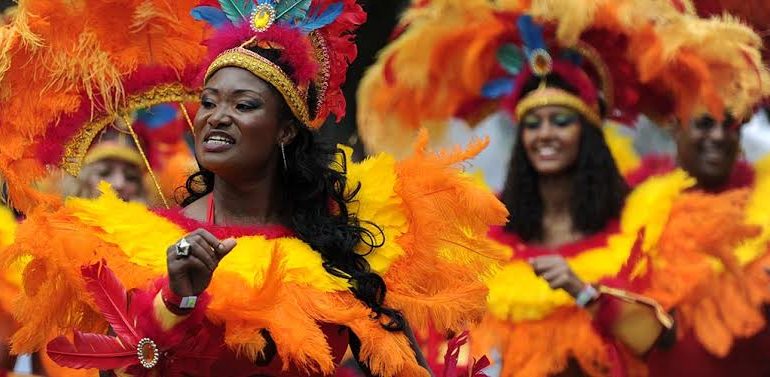Memories of Christmas in Calabar


By Udeme Nana
IT used to be fun trekking with friends along the streets – Mayne Avenue, Atu, Goldie, Orok Orok, Target, White House , Chamley, Bedwell, Hewett, Garden Streets ‘spooting’ red, gold, white or green new Christmas clothes with ‘googles’ in the eyes. Some would trek from Atamunu, Yellow Duke, Afokang while others would troop from Mbukpa, Ekpo Abasi, Marian, Akim, Etta Agbor or Big Qua. All traffic, vehicular or by foot led towards Calabar road, the city centre, where all masquerades would converge in a festival of masquerades. Those who trekked often broke into runs whenever they heard that the menacing matchet-clutching Ekpo (Ghost) masquerade, especially the legendary wild ones from Uwanse, Mount Zion or Abasi Obori part of town were nearby. Spectators walked, and sometimes walked and ran at the same time, often tripping and falling over one another along the crowded streets when Nnabo from Efio Ene, Edibe-Edibe, Hawkins or Nsa Ewa streets were on sight.
Initially named Calabaros by Portuguese merchants who were the first Europeans to berth there, the name was later anglicized to Calabar. It also has an endearing alias, Canaan – the legendary city flowing with milk and honey. There’s even a tune to it – ‘Oh Ediye Obio Canaan.’ This city of high culture had an allure. It always had the carnival at Christmas. Nnabo with it’s deadly, ghostly mkpokporo was usually guided with a leash. That was my favourite. I loved their chants like enyene eyen eka ada ediooooo, mmada okim mmong nkok ibok… (imagine that)! I loved the occasional wild clanging and crossing of swords which sometimes turned bloody between Nnabo from Edibe Edibe, Esighi, Nsidung and opposing ones from Atakpa, Palm street or Mount Zion.

The maidens who danced to the rhythms of abang (calabash), samba and moninkim were always a spectacle to watch with their sexy twists and turns. That reminded people of the Brazilian and Portuguese heritage in Calabar. Dance styles like etighi, konkoma or the trending twerking fad didn’t start today! Grandmothers who were voluptuous maidens years back could ask contemporary slay queens to fall behind and watch them lead the way. How about Korikori nniong nniong – the masquerade that would shorten into a dwarf in one moment, and in an instant, would grow in height, becoming tall enough to kiss the clouds in the sky?
Okpo ntaha ekpad (the masquerade of torn sacks) – aptly named so because they used old and torn sacks for costume – were the clowns who wielded short brooms like night-soil men (obiom) of that era.
I still remember Ekong ikong ukom (the one dressed with dry brown plantain leaves) reputed as the ‘King’ of all Efik masquerades. Would the initiates of the more popular Ekpe masquerades contest this. After all, Ekpe is more colourful. All other masquerades had to bow to Ekong Ikong Ukom whenever their paths crossed otherwise they would resort to Nsibidi to test one another’s knowledge of the extra mundane and esoteric communication known only to initiate masquerades. That was the ultimate test of superiority.
I used to like Akaba – another wild specie! And Nnuk (Horns)! It’s weapon was the horn which it uses in pursuit. Itiat Abasi Orok was where they all gathered to pay homage to that effigy of one of the heroes of Efik folklore, Abasi Orok! Have I mentioned Tinkoriko ayadia mboro or Udotod?
Other masquerades which made people to sing and dance about Calabar as the place to be at Christmas included Ekporoko (stockfish), Iboor, Okukim, Akaba, Mkpokporo (the skull ) – very menacing in it’s floor-sweeping, all black attire from head to toe with human skull on its head. Some turned out in red. These were the real ghosts and were always on a leash held by adepts who understood their ways. Sometimes they walked and sometimes they broke into a run which scared the people around.
I also remember the other one called Ofiom Inyang (the crocodile)! Obio Okpo – this long-legged masquerade was a spectacle usually accompanied by utu ekpe (spider masquerade) – the masquerade that would ride a bicycle or a motorcycle on a rope tied between poles! Their stunts were magical, stunning and breathtaking all at once.
Christmas was so much fun in Calabar, the city of my youthful years. The town drew cultural festivities like moths to light or as hedonistic men to women of easy virtue. It was a melting pot for masquerades from different places. Calabar always had the carnival at Christmas and during Easter. Long before Governor Donald Duke, a son of the soil, thought about Tinapa, there was already a song sung by the late highlife music maestro , Rex Lawson, titled ‘Uwem do ke Tinapa.’ It’s the spectacle of masquerades that gave life to the slogan – ukabade isua enem k’obio Efik – childhood can never be enjoyed a second time!
* Dr. Nana is the founder of Uyo Book Club



